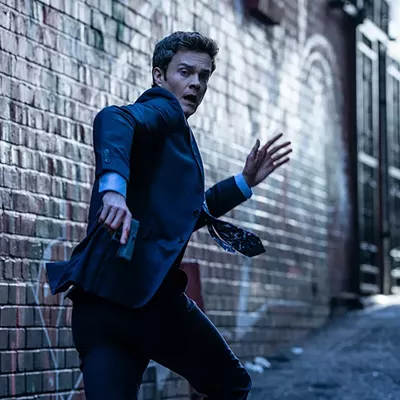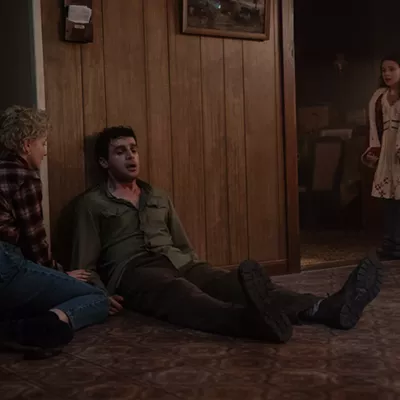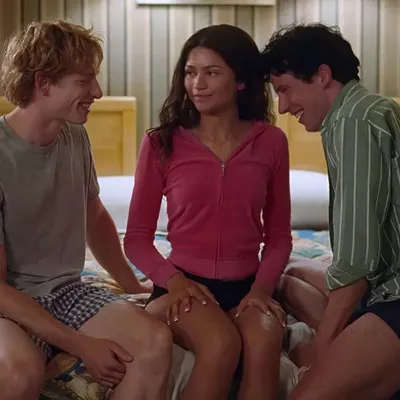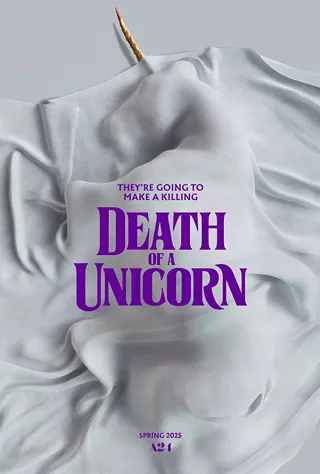So when I went to see My Winnipeg, I had low expectations. Was this going to be another of Maddin's wank-fest tributes to silent cinema, and another of his semi-autobiographical pictures that mines his mundane childhood for anecdotes that are of extreme interest and relevance to people named "Guy Maddin?" Would I struggle desperately against sleep while listening to its numbing narrative?
Well, surprisingly, the answer to these questions is, "Yes!" Wait. That wasn't a surprise. But surprisingly, My Winnipeg has lots of great moments, too. I could easily cut a riveting 35-minute movie out of its 80 minutes. Or, in fact, the whole thing could have been great, except for its one fatal flaw: the endlessness, droning voiceover.
Maddin himself narrates this semi-fantasy/semi-documentary look at the city he loves, and his family's place in it. Mixing found footage, re-creations and animation, he presents a surreal Winnipeg of the mind that's ruled by a cadre of Freemasons, 70-year-old guerilla hockey players, naked prostitutes and "hairless boner boys" (Maddin's term, not mine).
Some of this is fabulous. Some of it is just your stock assortment of hipster references, only from a 1980s hipster. Which is to say that the very original segments of the film are bogged down by some trite stuff that seems like it was pulled off the shelves of an NYU film student's library circa 1985. Yawn.
But all of it would work better if Maddin would just occasionally stop talking. In the few moments when the actors in his film have speaking parts (most of it plays like a silent movie, except for Maddin's pedantic/poetic voiceovers), the dialogue is tremendously weird, insightful and exciting. Maddin's capacity for invention comes to the fore here as well, notably during a scene where the young Maddin and his two siblings attack his mother with a parakeet.
But then he can't stop himself from going back to his monologue. About a quarter of the voiceover stuff is really brilliant, and if he would just leave the other segments out, and let the gorgeous, stilted imagery speak for itself, this would be a much more interesting film.
A bit about a furniture-exorcist, scenes from the imaginary daily TV show LedgeMan (each episode features the main character standing on a ledge contemplating suicide until his mother talks him in with promises of love and soup) and the unsettling sight of a group of senior citizens playing a vicious game of hockey as a wrecking ball takes down their stadium all stand on their own as perfect examples of what can and should be done with experimental cinema.
Then there's the other stuff.
I basically wish My Winnipeg was better, and that Maddin had trusted the movie a little more, and had indulged himself a little less. But still, his innate creativity shines through and occasionally overwhelms his innate narcissism. So if you're a fan of his films, you'll probably love this one. It's got all the magic and old-school cinematic stylings that he's known for; it's beautifully shot; and if you like references, well, it's loaded with references.
The strongest reference is to Things to Come, the 1936 sci-fi about a post-apocalyptic world where sleepwalkers spread disease and despair. In Maddin's Winnipeg, the city is awash with sleepwalkers, and its buildings, streets and constant snowfall create a soporific effect upon the entire populace. "So tired," Maddin keeps saying, as images of people yawning and dozing off fill the screen.
This is a really bad idea for a movie, by the way, because you're pretty much daring the audience to go to sleep, especially with the beautiful, soothing and atmospheric minor-key music that plays throughout the film.
But if you can get past its sleep-inducing power, and you don't mind listening to Maddin whine on and on about himself if it means he'll occasionally wax poetic on the way footprints form in snow, and you love old movies, the surrealism of the heart and personal explorations of personal space, then you might just love My Winnipeg. Considered as a type of itself, it's pretty much perfect. I mean, that's a tautology, but still.










